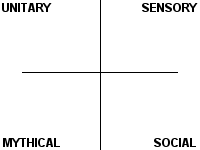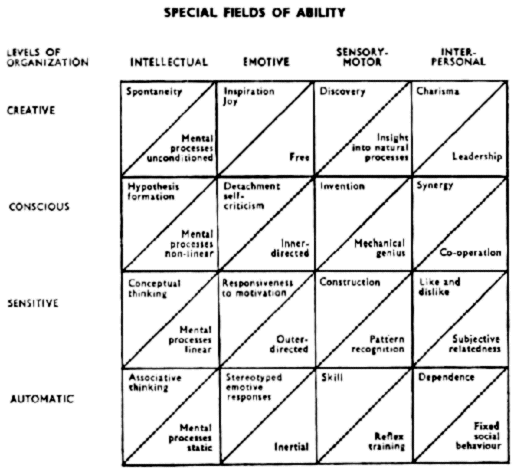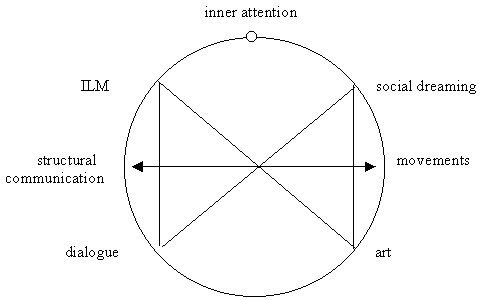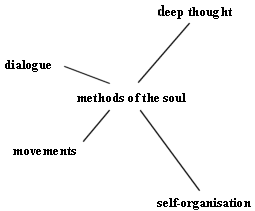Event Design
The DuVersity, following from J. G. Bennett’s concern with the education of the Whole Man, is developing a method of designing seminars to integrate the various aspects of our total experiencing. Such seminars have short duration but seek to create a true ‘atom’ of integration that can serve to nucleate other more random elements of learning around it. The basic principles for this methodology derive from the accumulated practice of the fourth way and the theory of systematics. But the method of design arose in the first place out of practical experience and has only recently emerged as being susceptible to systematic principles.
Seminars
We have accumulated experience with running seminars over one, two, three or more days. These have involved from six to ninety people at a time. They have all been concerned with enabling people to access meaning in themselves, though sometimes focussing on ideas and sometimes on experience. Increasingly, there has been less and less evident ‘teaching’ in them and less and less reliance on the personal inspiration of any ‘leader’. We have reached a point at which it is necessary to review and understand the evolution we have been through.
The main emergent pattern has been to rely on people finding for themselves what they need rather than pushing them in any set direction. This is easier said than done. The principle we have adopted can be expressed by Gurdjieff’s words: ‘Here we can only create conditions for work. We cannot do the work of people for them.’
We have taken the ‘creation of conditions’ to mean the structuring of a series of actions that, taken together, should enable people to come to their understanding in their own time if they are willing to make it happen for themselves.
Design
The design of events is based on a combination of an image or model of the whole human being with a repertoire of available methods for generating corresponding experiences. What we do depends on how we understand what a human is and can be – but also on what we can do to facilitate human development.
We believe that the human being we deal with (including ourselves as facilitators) is both fragmented and whole. It is the tension or field between these two that makes life interesting and difficult. It is also makes education and development possible and meaningful, as well as hazardous. Not only are people inwardly in separate bits, but they act with each other as separate entities, sometimes in conflict and misunderstanding. What we find internally is manifested outwardly and what we find outwardly is reflected internally.
Our repertoire depends on what we can know, do and experience ourselves. This entails more than passing acquaintance. There has to be a certain mastery of any given method in order to show it to others. In most cases, the methods we use are based on years of personal experience and practice. Other people in other circumstances and with other histories might well use other methods, just because of this. At the same time, we believe that there should be sufficient generality in the approach for other methods to be used to the same end.
We refer to the organisation of the methods we use in terms of structure. It is the structure that might have general application. The various methods we use are then simply techniques that have their meaning within the structure.
| WHOLENESS | ||
| TECHNIQUES | STRUCTURE | |
| FRAGMENTATION |
This general model might apply to therapy as well as education. We like to refer to what we do as ‘integrative experience’ because this leaves the content and particular focus of the design unspecified. It is also important to note that our understanding of the human being is reciprocal to our ability to work with people. It has not been our concern to ‘teach’ people about models of human beings, whether derived from Jung, or Gurdjieff, or any other authority. Instead, we have been concerned with involving people in an action through which they may learn in a way appropriate to themselves.
Models
An integrated experience should bring together in harmony the working of the different facets of the human being, taking into account his or her life-context. The simplest model we use involves four such aspects.
Interpersonal Intellectual
Emotional Sensation-movement
Most people will recognise these categories. Or some other version of them. We give Will McWhinney’s tetrad – used in management consulting – for comparison. It is far from identical while being ‘much the same’.

To explain the first model more, we must emphasise for example the importance of sensation-movement. The two are coupled together because they are two aspects of the same function, though often divorced from each other in life. The ‘interpersonal’ is made a separate category, which is not always the case. It can be considered as a synthesis of the other three but with a bias towards the emotional. But it is also the all-important function by which we can take part in social and cultural actions, involving a different kind of consciousness to solitary experience. Its basic fields of action are sex and dialogue.
We follow the argument of Gurdjieff that only an action in all centres of experience can make a difference to what we are. Thus, for example, we cannot truly understand something unless we think, feel, sense and exchange with others.
Below we insert Bennett’s grid of function against level, as he understood it in 1969. This is only by way of illustration to give an overall impression of what we mean by working from an elementary model of diverse aspects of human experience.

The integrative aspect of changes in level is better expressed in terms of an image such as:
Emotion is more than feeling angry or happy. It includes the capacity to feel meaning. It is also in the ‘sense’ of beauty and goodness and rightness. This example tells us that we have to consider the four functions also in terms of level. Here we refer to Bennett’s model of mental energies, in which we distinguish automatic, sensitive, conscious and creative levels. For the most part, our concern has been with engaging the conscious level of operation. The usual emotions that stir us are rather like reactions on the sensitive level, while those on a conscious level can be such as an aesthetic sense of wholeness, and other feelings that have to do with our apprehension of being and wholeness.
At the conscious level we can integrate the diversity of our experience. Below that level, things tend to be compartmentalised. Thus, at the conscious level we can, as is said, ‘Feel our thinking and think our feeling’. We can also use words in a way that involves sensing
what they mean, so that they are more than abstract signals and labels.
In another kind of picture, we can see how the various parts or functions can become more integrated together, the higher the level of operation.

In yet another version, the various levels of operation are described in the following terms:
Level one (automatic): each function separate from the others
Level two (sensitive): two functions in contact with each other
Level three (conscious): three functions working together
Level four (creative): four functions fusing together
These are just suggestive images to express the kind of thinking we are using. The models are not the reality, only how we might talk to each other about the reality.
Methods
The methods or techniques we use are drawn from many sources, with many of which we have an extended history. They do not all come from the same ‘school’ or ‘tradition’ and have not, as far as we know ever been drawn together in the way that we have done. Our integration of them is based on the belief that they represent something that is already integral in our very nature. The basic thing we have to do is to bring together sufficient diversity and make conditions in which they can connect with each other.
In the realm of methods, we use a pragmatic four-term system of
| SEEING | ||
| EXPRESSING | TALKING | |
| MOVING |
These four main actions are featured mainly in
| Inner attention | ||
| Art | Dialogue | |
| Movements |
Inner attention is developed in the practice of ‘sittings’ in which people are guided through work on the sub-elements of consciousness such as sensation, feeling and thought. This practice is based on the inner exercises developed by John Bennett from what he received from Gurdjieff and others.
These same energies are brought into dynamic interplay in the ‘movements’ created by Gurdjieff, which constitute an extraordinary repertoire of structured actions. Movements and inner attention form the vertical axis of the process – both deriving from the fourth way. But these are valid only because we have had decades of experience in them. It should be possible for people working in another tradition to do things that are equivalent if they have the history.
Along the horizontal axis, we have put ‘art’ and ‘dialogue’. The art we use is various, but most of the time is taken from the work of Dr Edith Wallace, a Jungian, who has developed a remarkable technique of using tissue paper collage to allow images to surface from the unconscious. One of us has worked for many years with Edith on this method.
‘Dialogue’ is the method mostly made known by David Bohm but originally fostered by Patrick de Mare in what he calls the ‘median group’. Patrick’s work goes back to the 30’s and involves decades of work in psychotherapy. We have ourselves worked with dialogue over ten years and become closely associated with Patrick’s endeavours in the field.
Again, it should be possible to adopt some other methods or traditions, just as long as there is some expressive art and concentrated free conversation. The expressive art comes from the unconscious into the conscious, while dialogue can work the other way round. The two complement each other.
Other possibilities cluster around these four and we can mention three of them.
‘Social Dreaming Matrix’ derives from the work of Gordon Lawrence and entails people bringing forth their dreams for group free association reflecting on their common situation. It can be positioned mid-way along the horizontal axis.
ILM is a way of listening to music to enhance creativity. It can be positioned between art and inner attention.
Structural communication is discussed at length in a separate article. It can be positioned between dialogue and inner attention.
This leaves three more possibilities to make a complete system. One of these is probably between dialogue and movement – which signifies ‘practical work together’. This has been traditional in fourth way schools but suspended for a time with us because of the implications of getting people to ‘pay for working’. This will, however, be pursued in the future. Between movement and art (expression) we suspect that something like ‘walking meditation’ will become relevant.
Between inner attention and movement is what can be called self-organisation. This is a complex matter because it means having the participants involved in making the structure of the whole event. This is a higher-order activity.
Integration
To form a structured whole of a series of actions means to have both a meaningful linear order and also a set of interconnections that bind them together. This ‘nesting’ of actions within each other is conducive to integration. In our present model, we have seven actions, which take place in the following sequence during a day:
1. Inner attention
2. Social dreaming
3. Movements
4. Art
5. Dialogue
6. Structural communication
7. ILM
These are pictured as if arranged in a circle:

The double-headed arrow links the two sessions that are most highly structured in form. The top point is also part of this, as it is also of the other figure of four. The four are all more open-ended and rely on the media involved for their coherence. Social dreaming uses the medium of free association about dreams, art uses the medium of collage (or some other means – we have also used clay modelling), dialogue uses the medium of conversation and ILM mostly the medium of music. ‘Media’ – in this tangible sense – are reflections of Ted Matchett’s ‘Media’ – see article on ILM. They provide loose structure, sometimes called ‘nets’. The top term of inner attention utilises the medium of the body ‘from inside’.
The diagram is derived from the formalism of N-grams – a part of systematics that includes the enneagram. This is not the place to explain how such diagrams are made. It is enough to say that they provide a way of checking for internal coherency within a linear order. It is good if the participants come to ‘feel’ this structure as it is working rather than having it explained to them. However, the structural communication session gives an opportunity for it to be discussed and conceptualised.
Linear order is important but involves only the sensitive energy. The inner connections are realised in consciousness. In the sequence through the day, we set up complementarities that balance each other.
Social Dreaming – Movements
Art-Dialogue
Structural Communication-ILM
In the inner connections, social dreaming, art, ILM and dialogue interweave in the process of ‘unfolding meaning’ – to use a phrase of David Bohm’s.
The structure we use is not a formula, only a useful guide. It is in fact very similar to the way in which ancient texts were structured for ease of memory and also to convey subtle insights (see separate article on systematics).
Seminar- Dialogues
Over the last four years, the DuVersity has conducted a series of relatively large events focused on particular themes:
1997 All and Everything – the structure of wholeness
1998 On Time
1999 Ways of Higher Intelligence
2000 Humanity – emergence of a global experience
Our aim in this series was to bring together some diverse inputs or points of view and create conditions in which these could be processed in the experience of the participants. We had no wish to have ‘conferences’ that are only platforms for the speakers. To achieve this aim, we designed six different kinds of session. There were variations but, for the most part, this was the pattern:
1. Presentations – where speakers present as one-to-many their points of view
2. Workshops – where the speakers interact with the participants
3. Experiential – where participants can experience a method for themselves
4. Informal – where participants and ‘experts’ can mingle
5. Dialogue – where everyone comes together in conversation
6. Performances – where participants and speakers share in a collective experience
The enneagram shown below exhibits the ideal or normative structure. The actuality fell short of this ideal.

It was hoped, but rarely realised, that participants would form their own ‘interest groups’ and that this would be the core form of the ‘informal’ sessions. The ‘experiential’ sessions should have included inspiration and guidance for the participants to conduct their own events. However, pressures of time and space inhibited this. It was also in mind that both presenters and participants could begin to come together more ‘on the level’ in the interim phase of the process. But there was not enough guidance and support for this to happen, with an overfull schedule. Consequently, the bottom third of the enneagram tended to collapse leaving only four main types of event.
These failures meant that the inner connectivities – only though which the whole complex can be integrated – also tended to collapse.
However, although the actual event lacked in certain ingredients, these were in part fulfilled on other occasions. One of the features of the seminar-dialogues is that they initiated contacts between people that were followed up later – some of them only years afterwards!
Methods of the Soul
We are in process of designing a new seminar-dialogue for the year 2001. We are in process of conceptualising and feeling what it might be like. As yet, we have only some inklings of what could or should be done. These spares ideas are given here to emphasise the exploratory and emergent nature of the enterprise of ‘event design’ for us.
One of the key features of this new event might be the addition of a physical-based action involving everyone, besides the mode of talking together in dialogue, probably movements. It should also involve practical guidance in group formation, time being allocated to the participants to create their own formats through ‘self-organisation’. The presenters should be more available as resources.
At the same time, it is hoped that a much higher level of concentration will be realised. There are certain ideas that are also deeper perceptions and cannot be realised without inner work. It does not matter how well or how badly a presenter explains them, what matters is the step whereby the listener makes them real for themselves. As Gurdjieff once explained: ‘The only true initiation is self-initiation.’ Let us call this ‘deep thought’.
Here we face a considerable challenge. The two aims of furthering participative self-organisation and furthering penetration into key ideas may be seriously in conflict. This is not the only issue. At the present time (May 2000) the most promising structure to entertain may be a pentad such as:

IMMANENT TRANSCENDENT
